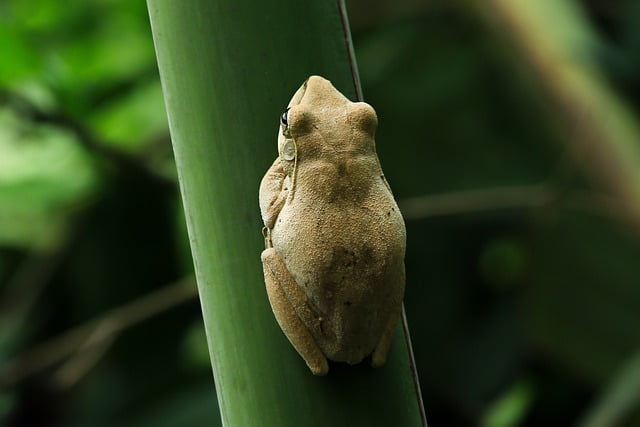When the succulent berries of summer disappear, fishes begin to migrate and trees become practically in differentiable from their resulting understory, where do moist and creepy amphibians like frogs and toads go? What do they do in winter? Do they migrate to warmer places and mimic the survival strategies of fishes, whales and the deer-like caribous or do they selectively remain in their modal habitat and face the savage nature of winter bare naked?
The answer is simple.
Frogs forcefully transition into a state of suspended animation for the most part of winter. They remain periodically inactive while nestled deeply below the frost line of tropical solis or hiding nookly in rock cracks, cervices or peeling backs of tree trunks.
In short, frogs completely hibernate their way out of winter. This is an effective, highly taxing but extremely rewarding strategy that is crucial for their survival. In the next section, you’ll find out why.
Note: I used ‘hibernate’ throughout this article only because of how nicely it fits into sentences and context. Frogs actually cannot hibernate since they are cold blooded and therefore cannot actively repress their body temperatures or other physiological activities like metabolic rate.
They experience these reductions only as a result of the direct influence of the drop in ambient temperature which drags down their body temperatures along with.
Why do frogs hibernate?
The reason is simple. Frogs hibernate in order to dodge the biting precipitations of the winter climate and also the savage, long and ruthless famine that often accompanies it.
During the mid-sessions of the winter season, ambient temperatures plunge dramatically so low and the internal temperatures of poikilotherms like frogs and toads also drop concordantly with it.
In this condition of low body state, normal activities like breathing, pumping of blood and even foraging becomes energetically too costly and in some cases practically impossible.
As a keen and important strategy for saving energy, and given that most poikilothermic ectotherms like frogs and toads are capable of surviving even on such low bodily conditions, they retire mostly into protective areas like soils and lake bottoms and remain so (mostly seeking protection from predators and consistently saving energy) until the productive vegetation of spring approaches.
How do frogs hibernate?
Aquatic frogs hibernate under lake or pond bottoms. They settle comfortable on the surface of water muds and breath actively using permeable membranes spread all over their skin surface.
Frogs dont completely bury themselves underwater muds for the safety precatution that they may end up oxygen-deprived. Which could be the end for them, since migrating into another region of oxygen abundance would cost them energy, even more than they can afford.
Water muds have an extremely poor level of dissolved oxygen. Turtles are only able to survive deeply under them as a result of the low rates of metabolism they posses.
Frogs are no turtles. They metabolic rates are only within the range that can easily cope with the oxygen levels of the water above them. If they every try to stay underneath water mud for prolonged periods, they’ll end up suffocating to death.
When aquatic turtles hibernate, many of their bodily activities like metabolic rates, heart rates and breathing rates are significantly reduced.
Before thay can survive through winter under such conditions, they must first of all deposit enough body fats that can comfortably fuel all these forcefully suppressed processes.
Frogs with deficient body fats can be seen moving underneath the infrequent frozen lake tops and foraging for food. Frogs can also move around (during hibernation) in order to properly capture water oxygen and circulate it within their bodies.
Frogs hibernating underwater have reduced internal core temperatures nearly the same as their outer and relatively warmer environment. On a normal day, they are able to deal with temperature fluctuation this low without running into any problems at all.
Terrestrial frogs hibernate in a variety of places. The avid diggers like the American toads burrow their way below the frost level of soils. Going below the frost level prevents their bodies from freezing at all. In cases where the frost line actively changes as winter progresses, frogs can be seen changing their position by rising or falling in concordance.
Frogs that suck completely at digging, the likes of wood frog and spring peepers can observe their physiological leave in downed logs, peeling barks of tree trunks, in rock cervices, cracks, or in the exposing depths of forest leaf litters.
Frogs that mostly fall into this category occasionally have some of parts of their bodies completely frozen as a result of the poor insulate nature of their denning areas. Scientist estimate that around 50 to 65 % of their total body water becomes frozen.
While unimportant areas like the body cavity and bladder may become frozen, vital organs like the heart and lungs remain unfrozen throughout winter.
This is made possible by their liver’s production and deposition of large amount of glucose around these organs which help prevents ice crystals from forming around and within their cells.
As these organs are crucial for survival even in this measly condition, rupturing and breaking of cells within these areas may lead to the frog’s death. So they evolved to secrete glucose around these organs to prevent freezing.
Frogs hibernating on forest grounds also have drastic reductions in their bodily activities. Metabolic rates, heart rates and breathing rates significantly decreases with respect to ambient conditions. Some frogs species may even stop breathing at all. Some can even record zero brain activity and heart beat for the entire period of their hibernation.
All these behavioral and physiological extremities enable them to live primarily on their small energy reserves (fats) until their diet of tiny insects in spring become abundant.
More interesting articles
Cite this Article ” (APA Format)
Bunu. M. (2020, June 27). Do frogs hibernate?. Retrieved from http://emborawild.com/do-frogs-hibernate/

